2009 VOLKSWAGEN JETTA engine
[x] Cancel search: enginePage 327 of 477

Booklet 3.2 T ips a nd Advice
Power steering
011 vehicles with pow er stee ring , th e of power ass ista nee is regu lated e lec
t roni call y acco rdi ng to vehicle speed, stee rin g wheel torque and stee rin g w hee l
angle.
Th e power assis tance prov ided in the power
s te erin g sys te m is not hydrau lic, but m e
c h ani ca l usin g an elec tric mot or. The adva n
t a ge s of this steer ing system includ e th e fact th at
n o hydra ulic co mponents such as hoses, o il co n
t a in ers ,
o r fl uid s are re quired.
Fu rth ermo re , t his is co nsiderable de crease in
e n ergy req uir e d . T he e lec trome chani ca l s tee rin g
sys te m . in contras t to th e hydrau lic sys te m
(w hich re qu ires a co nstant flo w of fluid ), only
co nsume s energy when th e ve hicle is actua lly
be ing stee re d.
T he fu el consump tio n i s re du ced as a res ult.
If th e electro mec han ica l p owe r stee ring sys te m
fa ils, the pow er a ssis ted stee ring system
w ill still
work. If th e engin e is sw itch ed off, the pow er s
teer ing does no t fun ctio n and th e steer ing
wh eel is ve ry hard t o tu m .
WAR NING
Turning th e s teer ing whe el is very w hen t he power s tee rin g sys tem is n ot
work ing and it is harder to co ntrol the veh icl e.
• Neve r le t t he veh icle coast with th e engine
swit ch ed off.
Do no t kee p th e steer ing wheel turned all the 10 left or righ t fo r m ore than 15 seco nds
w hen th e e ngin e is runnin g. Doin g so co uld
damag e th e powe r steer ing
Data
H eco rder (EDH ), in sta lled by so me manufa c
tur ers
the exp ress purpo se of ca pturing data
fo r retr ieva l aft er an acci den t or cra sh eve nt.
are so metimes called "cras h recorders".
So me s tat e laws res tr ict t he re tri eva l or down
loadin g of da ta sto re d by ED
that were in
s ta lled in a vehicle for the exp ress p urpose of re
tr iev ing dat a af te r an acc ident or crash event
wit hou t th e Owner's conse nt.
your vehicl e is not equipped with an it is equipp ed with number of e lec tro nic
contro l modu les for variou s vehicle sys te m s
s u ch as, fo r ex am ple . e ngine function, em iss io n
6 Smart t echno logy
co ntrol, as we ll as fo r th e airbags and safe ty
be lts.
The se elec tronic con trol mod ules also
ve
hi cle-re late d dat a dur in g nor mal ve hicle ope ra
ti on for diag nos tic and re pair purp oses. The re
cordi ng capaci ty of the e lec tron ic co ntro l mod
ul es is limit ed to data (n o so und is record ed ) a nd
on ly a small amo unt of data is ac tually reco rde d
ove r a very limited p eriod of tim e and stor ed
a sys te m fau lt or o th er co ndition is se nse d by co ntro l un it. So me of dat a th en sto red
m ay re late to ve hicle sp ee d, direc tion, braking as
well a s res traint system use and performan ce in
th e eve nt of a cra sh or o th er conditi on. S to red
c an only be rea d and downloade d wit h spe
cia l
Page 328 of 477
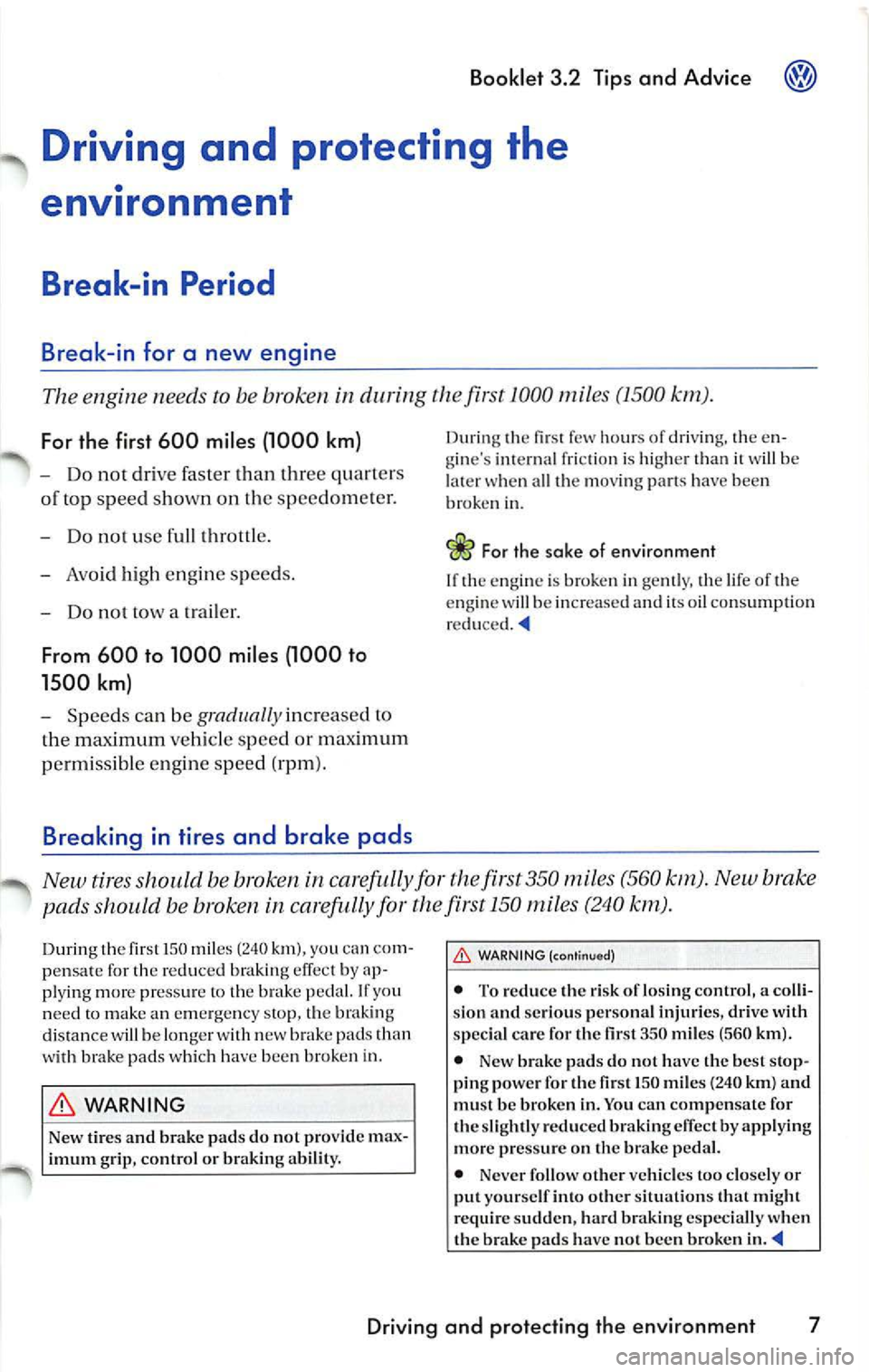
Booklet 3.2 Tips and Advice
Driving and protecting the
environment
Break-in Period
B reak-in for a new engine
The en gine needs to be broken i n during the first 1000 miles (1500 km ).
For the first 600 miles (1000 km)
- Do n ot dri ve faste r than three q uarters
or top speed shown on th e speedo mete r.
- Do not u se full th rott le .
- Avo id high eng ine speeds.
- Do not tow a tra iler.
From 600 to 1000 miles (1000 to
1500 km)
- Speeds ca n be grad ually increased to
the maximu m vehic le speed or max imum
perm iss ibl e en gine spee d (rpm ).
Breaking in tires and brake pads
Durin g first few hou rs of driv in g, the e n
g ine 's in te rn al fri cti on is hi gh er than it will be
all th e m ov in g pan s ha ve bee n
broken in.
For the sake of en vironment
lfth c engine is brok en i n ge ntl y, the life of the
e ngin e w ill b e in crease d and it s oil cons umptio n
New tires s hou ld be b roken in ca refu lly fo r the first 350 mi les (560 km). New b rake
pads s houl d be broken in ca refu lly fo r
first 150 miles (240
WARNING
Ne w tir es and brak e pad s do no t pro vid e m ax
imum grip , co ntrol or b rakin g abilit y.
W ARNING ( continue d)
• T o reduce th e ris k of los ing co ntrol, a colli
s io n and serious perso nal injuri es, drive w ith
s p ecial car e for the fir st 35 0 mil es (560 km ).
• New brake pads do not have th e be st stop
pin g powe r for the fir st 1 50 mil es (24 0 km) and
mu st b e bro ken in. You ca n comp en sa te for
th e sli ghtl y re du ced brakin g
by apply in g
mor e pr ess ure o n th e bra ke p ed al.
• Never fo llow other vehicle s to o clo sely or
put your se lf into oth er situ ation s th at mi ght
re quir e sudd en, hard br akin g es peci all y w hen
th e b rak e pads have not b ee n brok en
Driving and protecting the environment 7
Page 329 of 477

Booklet 3.2 Tips and Advice
Braking power and braking distance
Braking power and braking distance are influenced by driving situations and
road
Worn brake pads will not provide good braking.
The amount of wear and tear on the brake pads
depends to a great extent on the cond itions
und er which the vehicle is opera ted and the way
the vehicle is dr iven. If you do a lot of city
driv ing, drive short distances or have a sporty
driving style, we reco mm end th at you have the
thickness of your brake pad s checked by an au
thor ized Volkswagen dea ler more frequently
than r ecommend ed in the service schedule.
I f you dr ive witJ1 wet brakes , for example after a
dri ving through water,
heavy rainfall or
after washing the vehicle, brakin g power will be
reduced and sto pping distances w ill be longer
because the brake d iscs will be wet or in winter
ma ybe even frozen
the brakes must be dried
with severa l ca reful brake applications.
Brake fluid absorbs water and must be c hanged
every two years. Heavy use of the brakes can
cause vapor lock if the brake fl uid is too old.
Va por lock reduces braking power, increases
stopp ing distances and can even cause total
brake failure.
WARNING
• New tires and new brake pads do not pro
v id e maximum grip, control or braking abilit y.
• To reduce the risk of losing control, a colli
s ion and se rious persona l injuries, drive with
special ca re for the first
350 mil es (560 km).
• New brake pads do not have the best stop
ping power for the first
150 mil es (240 km) and
must be broken in. You can com pensate for
the slightly reduced braking ability by drivin g
w ith care and applying more pressure on the
brak e pedal.
• Never fo llow other vehicle s too close ly or
put yourse lf into other situ ations that might
r equ ire s udden , hard brakin g especially when
th e brake pads have not been broken in.
WARNING
Wet brake s or brak es coa ted ice or road
sa lt react slower and need longer stopping dis
tanc es.
• Carefully apply brakes for a lest.
• Alwa ys dry brake s and clean olT ice coa t
ings and salt coa tings with a few cautiou s
brake app lica tions.
• Always read and hee d all
in "Break ing in tir es and brake pads" on
page 7.
WARNING
Overheated brakes will reduce the vehicle's
s topping power and increase stoppin g di s
tances.
• Always avoid over hea tin g the brakes!
• When driving downhill, the brakes have to
work hard and hea t up quickly .
• Before driving clown a long, steep hill, al
ways red uce spee d and downshift to a lower
gea r. This will let th e ve hicle use engine
braking and reduce the load on the brakes.
• Always c han ge the brake fluid at least
every two years. Hard braking with old brake
fluid may cause a va por lock. Vapor lock re
duces brakin g power, increases s topping dis
tan ces and can even ca use to tal brake failure.
• A damaged front spoiler or new non stan
dard spoile r ca n reduce the airflo w to the
brake s and cause them to overheat.
• Always sec an au thorized Vo lkswage n
dealer or qualil1ed workshop if yo u think th at
you may have damaged the front spoiler.
• Be sure to read and heed all WARNINGS
and the information =-page 27, "Accessories
and part s" before buying accessorie s.
8 Driving and protecting the environment
Page 331 of 477
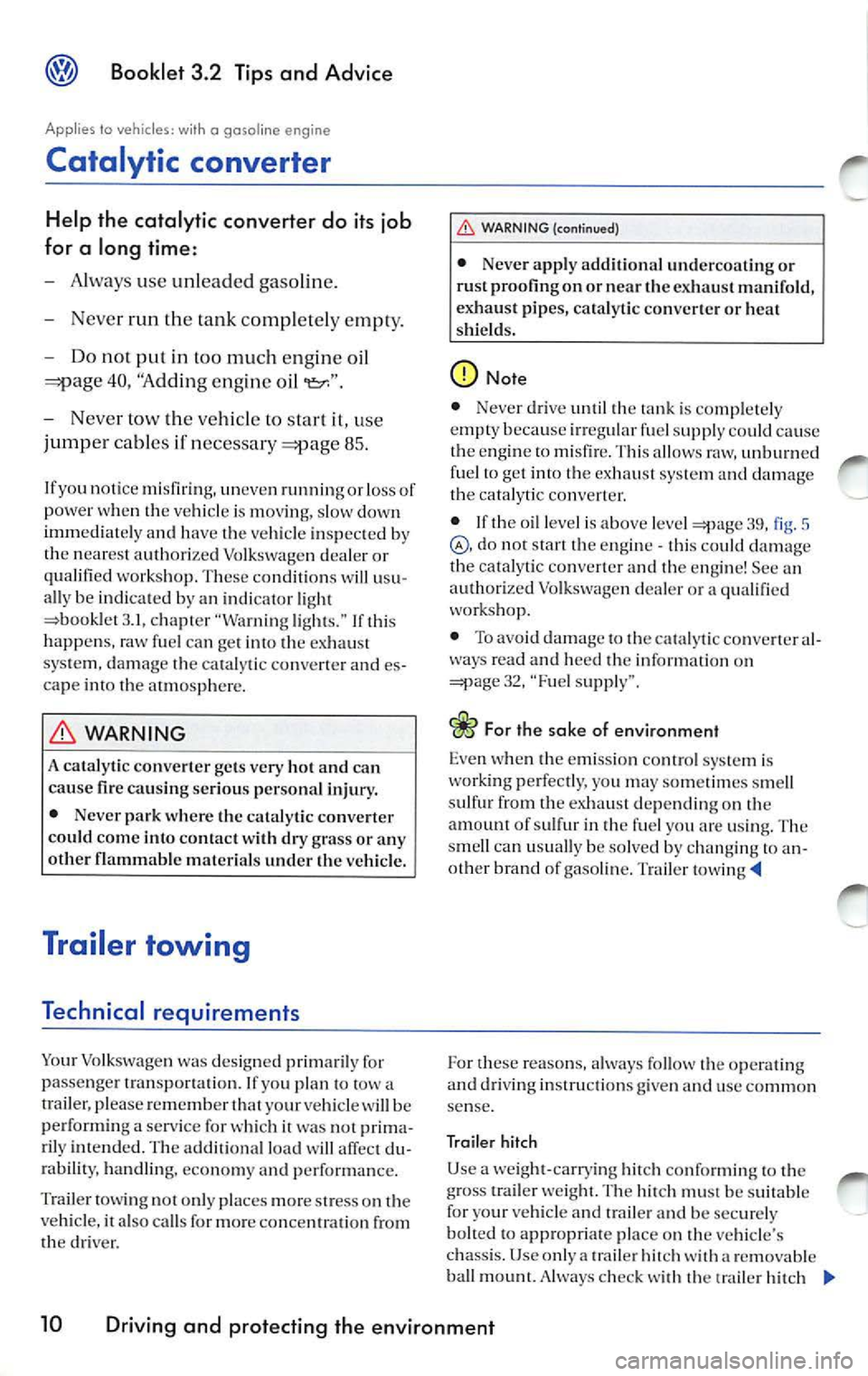
Booklet 3.2 Tips and Advice
Applies to veh icles: with o gaso line engi ne
Catalytic converter
Help the catalytic converter do its job
for a long time :
-Alwa ys use unl eaded gasol ine.
- Never
the ta nk complet ely empty .
- Do not put in too much en gin e oil
40, "Adding engine oil
-Never tow the ve hicle to start it, use
jump er cab les if n ecess ary
85.
If yo u notic e mi sfiring, uneve n runn ing or loss of
power w hen th e vehicl e is m ov ing , s low down
immediate ly and h ave the vehicl e in sp ec te d by
th e nea res t a uth oriz ed Volk swagen deal er or
qu alifi ed wo rksh op. These co nditions w ill u su
a ll y be in dic ated b y an ind icator light
3. 1, chapt er "Warning light s." If thi s
happ ens, raw f uel ca n ge t int o th e ex hau st
sys te m , d am age t he ca ta ly ti c co nverte r and es
ca pe int o th e atmosp here .
WARNING
A ca ta ly tic conver te r get s very hot and can
cau se lir e ca usin g se riou s personal injury.
• Neve r park where th e cata lytic converter
co uld come into conta ct with dry grass o r any
other flammabl e materials under the vehicl e.
Trailer towing
Technical requirements
Yo ur Volk sw agen was desig ned primaril y for
pas seng er tr an spor ta ti on. If yo u plan to
trai ler , plea se re m emb er th at yo ur ve hicle w ill be
p erformin g a serv ice for whi ch it w as not prim a
ril y in ten ded. The addit io na l lo ad will affec t du
r ability, hand lin g, econ omy and p erfor mance.
Tra iler to wing not only pl aces more s tress on the
ve hicle, it a lso calls for mor e co nce ntrati on from
t h e dr ive r.
WARNING (continued)
• Never appl y additional under coating or
ru st proofin g on or near the ex haus t manifold ,
exhaust pipes, ca ta ly tic conver te r or hea t
s hi elds.
39 , fig . 5 d o not sta rt the e ngi ne thi s co uld dama ge
the catalyt ic c onverter and the e ngin e! See an
a uthori zed Vo lkswage n dea le r or a qualifi ed
works hop.
• To avoi d dama ge to th e ca talyti c conve rter al
ways rea d and hee d th e in formation on
=:page 32, "Fu el suppl y".
For the sake of environment
Even when th e e missio n co ntro l syste m is
worki ng perf ec tly, yo u may so metim es s mell
s ulfur from th e ex hau st d ep endin g on th e
a m ount of sulf ur in th e fu el you arc usi ng. T he
s m ell ca n usua lly be so lved by ch angin g to an
ot her brand of ga solin e. T railer
For th ese reason s, a lwa ys fo llow the o pera tin g
an d dri vi ng in stru ction s given a nd use comm on
se nse.
T railer hitch
U se a we ig ht -carry ing hitch co n fo rm ing
trail er hit ch re movab le
ball mount. ch eck with th e traile r hit ch
10 Driving and protecting the environment
Page 334 of 477
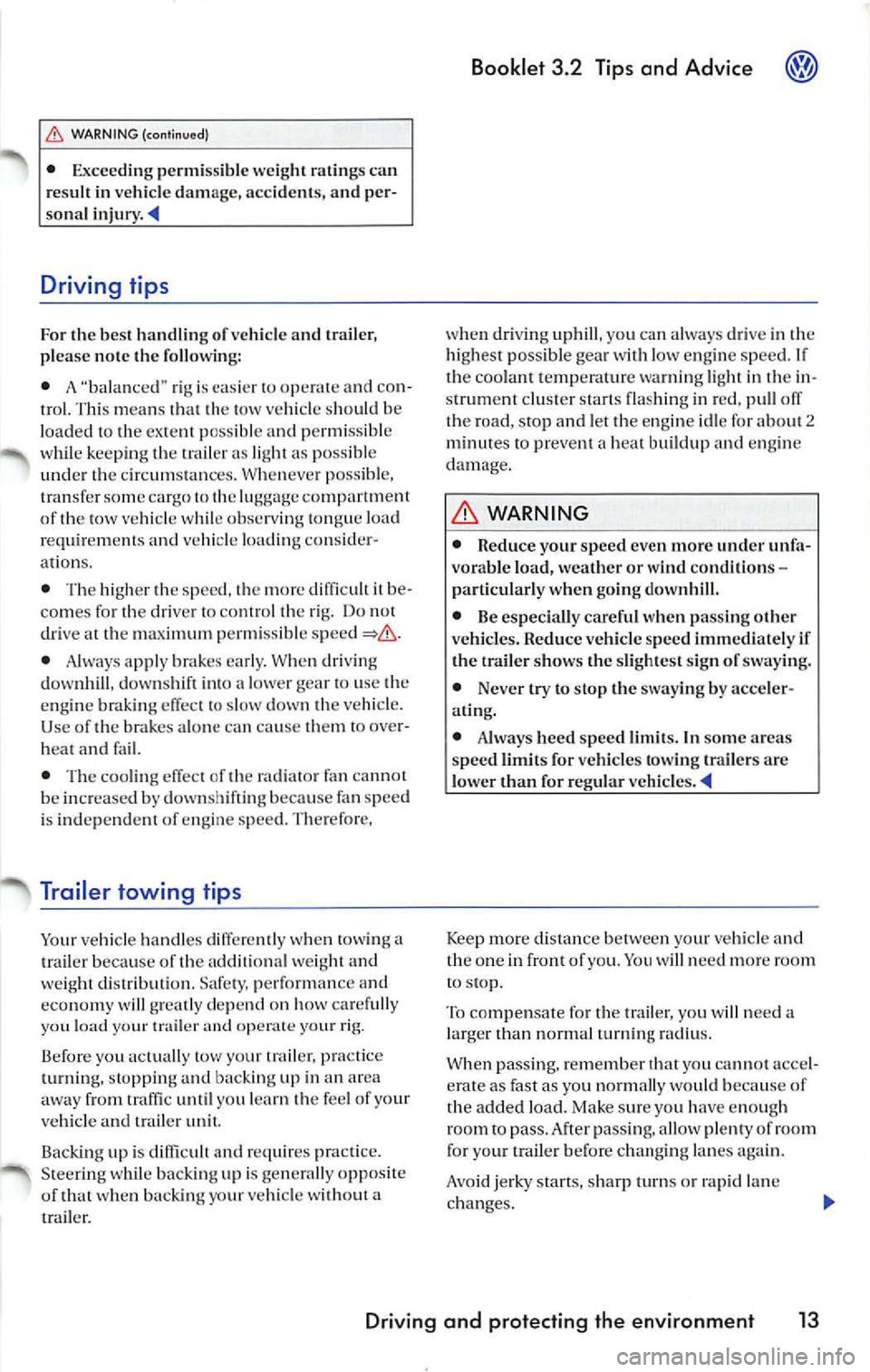
WARN ING (continu ed)
• Exceed ing permi ssibl e weig ht ratings can
r es ult in ve hicl e da m age, accide nts, and per
sona l
Driving tips
For th e best handlin g of ve hicle and trailer,
p lease note th e fo llowing:
• A "bala nce d" rig is easie r
operate and con
trol. This m ean s th a t th e tow vehicl e should b e
loaded to th e extent p ossible and p ermi ssible
whil e keep ing th e trailer as light as po ssibl e
und er th e circum stanc es. Wh eneve r po ssib le,
tran sfe r som e cargo to the
co mpar tment
of the tow vehicl e w hile obs ervin g tongu e loa d
req uirem ents and vehicle loa ding consid er
a tion s.
• The high er th e s pee d, the more
it be
come s fo r the drive r to control th e rig. Do not
dr ive at the maximum permis sibl e
• Always appl y br akes earl y. When driving
d ow nhill, d ownshi ft into a lower gear to u se the
e ng in e brak in g eff ec t to slo w down the ve hicle.
U se of the brake s alo ne ca n ca use them to ove r
h ea t an d fail.
• The coo ling effect of the rad iator fan cann ot
b e in crease d by dow nsh ifti ng beca use fan sp ee d
i s ind epend ent of engine sp ee d. The re for e,
Trailer towing tips
Your vehicle handles diff ere nt ly wh en t ow in g a
t ra iler b ecause of the a ddit io na l weight and
weig ht d is tribut ion. S af ety. perform ance and
e conomy will gr ea tly depend on how car efull y
yo u load your tra iler
yo ur rig.
B efor e y ou actua lly
your tra iler, practice
t urn ing. stoppin g and backing up in an ar ea
away from
until yo u l earn the feel of your
ve hicle and trailer unit.
Backing up is
r e quir es prac tice .
S teer ing w hile backing up is generall y opposite
of th at wh en backing your vehicl e w ith out a
tra iler.
Booklet 3.2 Tip s and Advice
wh en dr iving uphill , yo u can alwa ys dri ve in the
hi gh est po ssible gea r wit h low e ngin e sp ee d. If
th e coo lant te mp erature warning light in the in
s trument cluste r start s fla shin g in red , p ull off
the road , stop and le t th e e ngin e id le for abou t
minute s to pre vent hea t bu ildup and engin e
damag e.
WARNING
• Reduce you r speed even more under unfa
vora ble load, wea ther or w ind condi tions
p artic ular ly w hen goi ng dow nhill.
• Be especia lly carefu l w hen passing o ther
veh icles. Redu ce ve hicle sp eed immediate ly if
the tra iler sh ow s the sli ghtest sig n of sway ing.
• Neve r try to stop the sway ing by acceler
ating.
• Always heed speed lim its. In some a reas
speed lim its for vehicl es tow ing tra ilers are
l ower than for reg ular
Keep more di stan ce between your vehicl e and
th e one in front of you. will nee d m ore roo m
to stop.
To compens ate fo r th e traile r, yo u w ill n eed a
l a rger than normal tu rning
When passing , reme mber that you can not acce l
erate as fast as you normall y wou ld because of
t h e added load. Make sur e yo u ha ve enough
room to pas s. After passing, allow plen ty of room
fo r yo ur tr aile r befor e changing la nes aga in.
Avoid jerk y s tart s, sharp turns or rapid lan e
c h ange s.
Driving and protecting the env ironment 13
Page 336 of 477
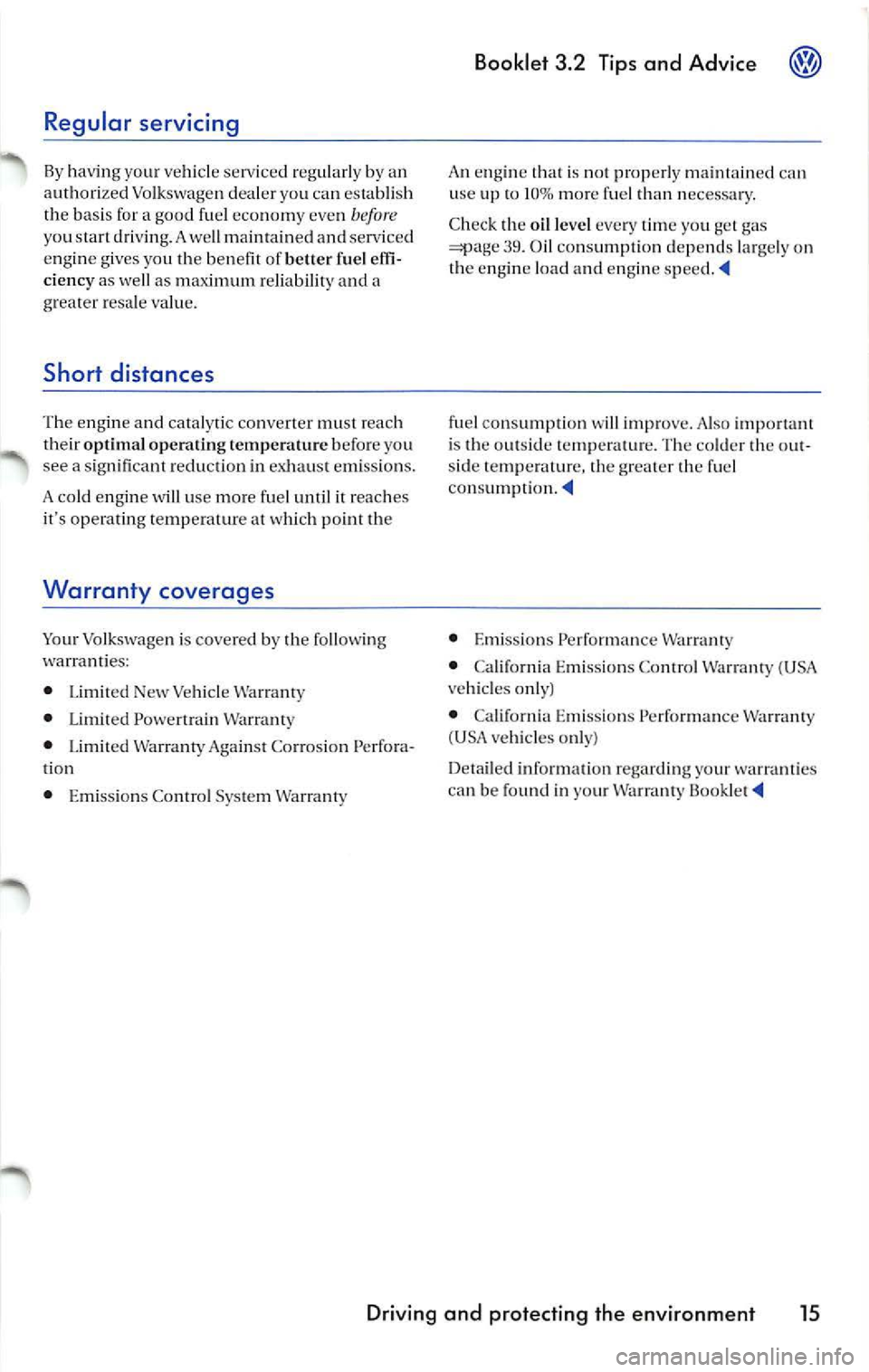
Regular servicing
By hav ing ve hicl e serviced reg ularly by an
aut horiz ed Volksw age n dea le r yo u ca n es tab lish
th e bas is for a good fuel eco nomy even
before yo u start driving. A we ll maint ain ed an d se rv ic ed
e n gi ne g ives you t he be nefit of bett er fu el effi
cie ncy as well as maximum re liabi liry and a
g rea ter res ale val ue.
Short distances
T he engi ne and catal ytic conve rter mu st reach
the ir o ptim al o p eratin g te m pe ratur e befo re y ou
se e a sig n ifi ca nt reduc tio n in exhaus t emi ssions.
A cold engin e will use m ore fuel until it rea ch es
it 's ope ra ting t emp eratur e at whic h po int th e
Warranty coverages
Yo ur Volkswagen is covered by th e follow in g
warra nties:
• Li mited New Ve hicle Warranty
• L imited Powertrain Warra nty
• Li mited Warra nty Aga in st Co rrosion Perfora
t io n
• Emi ssio ns Cont rol Sys tem Warranry
Booklet 3.2 Tip s and Advice @
An eng in e th at is no t p rop erl y ma intained can
use up to 10 % more fuel than ne cessary.
Check the oil l eve l eve ry tim e you ge t gas
39. Oil co nsumpti on d ep end s la rge ly on
t h e engine load a nd eng in e
fuel consump tion will impro ve. A lso imp ortant
i s the out sid e tempera ture. Th e co ld er the out
s id e te m peratur e, the g rea te r th e fu el
• Emi ssio ns Perfor mance Wa rranty
• Califo rnia Emi ssions Co ntrol Warranty (U SA
ve hicl es only)
• California E missio ns Perfo rmanc e Warranty
( U SA veh icles only)
Det ail ed informa tion regarding your wa rranties
ca n b e found in your Wa rra nty
Driving and prot ecti ng the envi ronm ent 15
Page 343 of 477
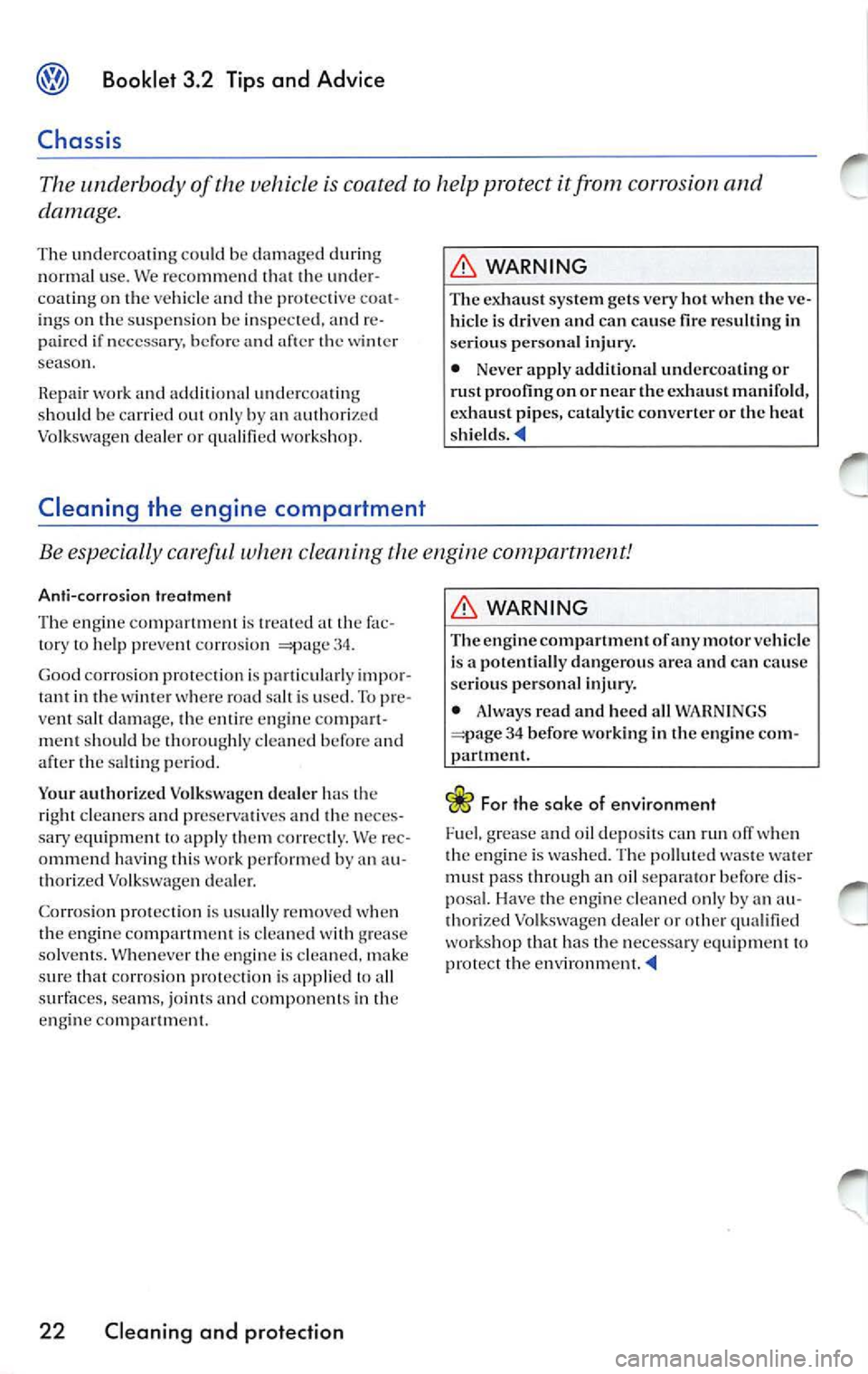
Booklet 3.2 Tips and Advice
Chassis
The unde rbody of the v eh icle is coated to help p rotect it from corrosion and
damage.
The und ercoat in g co uld be damag ed d uring
n ormal use. We recommend 1h a1 1h e und er
coali ng on th e ve hicl e and 1h e prot ec1ive c oat
in gs o n 1he s usp ension be inspec 1e d . a nd re
pa ired if necessary, befo re and afte r 1h c wint er
seaso n.
R ep a ir wor k and ad
V o lk swagen d ealer or qualified workshop.
Cleaning the engine compartment
WARNING
The exhaust sys le m ge ts very hot w hen th e ve
hi cle is dri ven and can ca use fire res ultin g in
se riou s perso nal inju ry.
• Never a pply additi onal und ercoa ting or
ru st proo fing o n or near the ex haust m ani fold,
ex haust pip es, cata ly ti c co nverter o r lhe hea t
Be especia lly ca refu l when cleaning the engine compartm ent!
Anti -c o rrosion tr eatment
The e ngin e compar1m en 1 i s 1r ea 1e d at the fa c
tor y to help preve nl corro sio n 34.
Good corro sion prole clion i s pa rlicula rly imp or
lant in 1he win ie r whe re roa d salt is use d. To pre
ve nt salt dama ge, th e entir e en gin e co mpa rt
m ent sh oul d be th oro ugh ly cleaned before and
after the sa lting p eriod.
Y our auth oriz e d Vol kswagen dea ler h as the
ri gh t cl eaners and pr eserv a tives a nd th e neces
sary e quipm en t to apply 1h cm correc 1ly. \Ve rec
o m mend havi ng
wor k perfo rmed b y an au
t h o riz ed Vo lkswage n dea le r.
Co rros io n pro tec tio n is usuall y remove d when
t h e e ngi ne co mpar1m cn 1 is cl ea ned with grease
s o lve nts . W hen eve r
engin e is clean ed , mak e
s u re that corros ion pro1 ec1io n is app lied 10 all
s urface s, sea ms, jo inl s an d co mponents in 1h e
e n g in e compa r1m en1.
22 Cl eaning and prot ection
WARNING
T he eng ine c omp artm ent of a ny mo tor ve hicle
i s a po te nti ally dangero us area a nd ca n ca use
se rious perso nal inju ry.
• Always read and h eed a ll WA RN IN GS
34 be fore wor king in th e e ngin e co m
pa rlm ent .
c£> For the sake of en v ir o nm ent
Fuel. grease an d oil d epo sit s can run off
th e e ngin e is wash ed. Th e po llu1 ed was te mu st pass throu gh an oil sepa rator befo re di s
po sal. H ave th e e ng in e clean ed only by an au
t h ori ze d V olk sw agen de aler or other qua li fied
wo rksh op that has the nec ess ary e qui pmen1 10
prot ect th e
Page 351 of 477
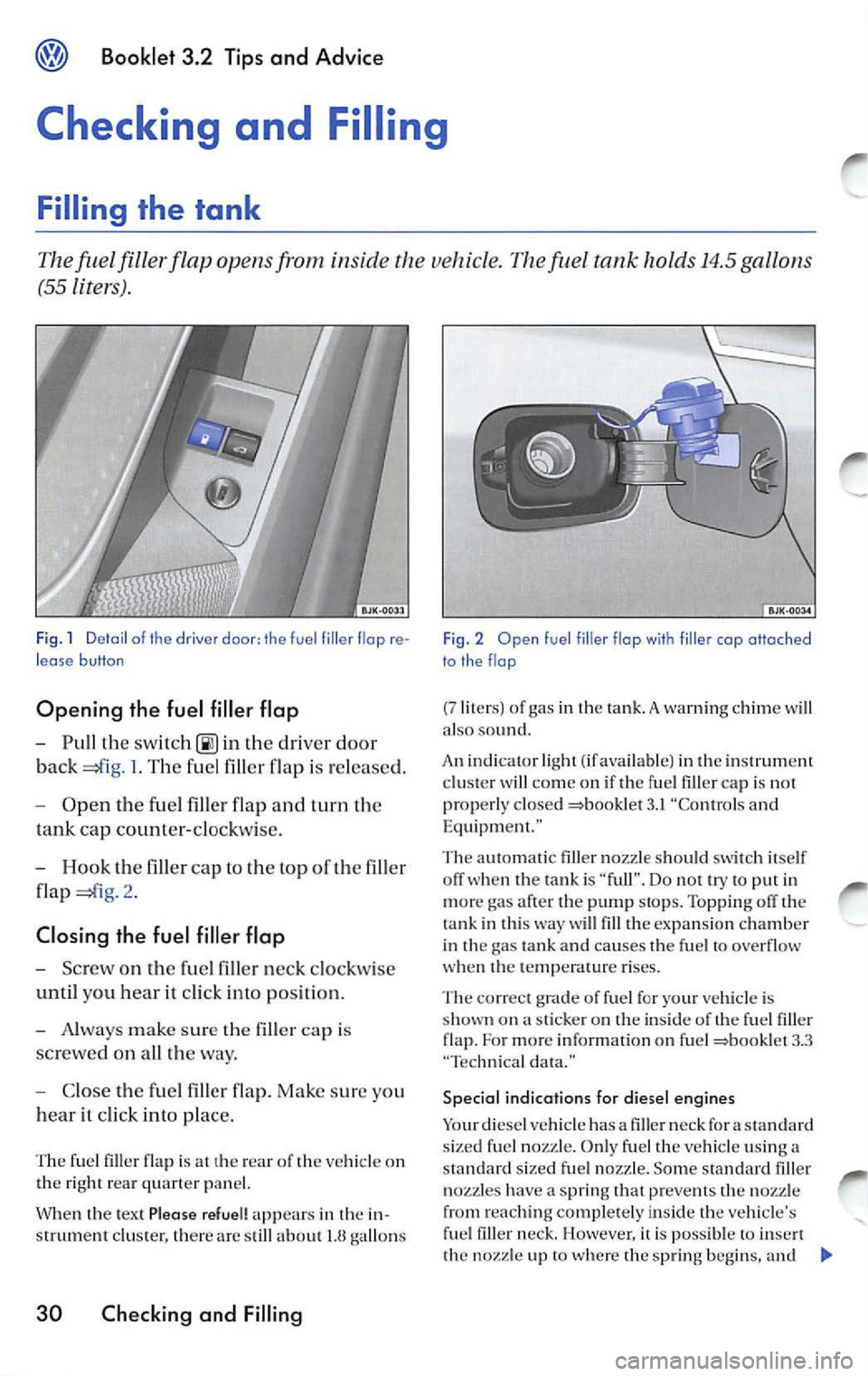
Booklet 3 .2 Tips and Advice
Checking and Filling
Filling the tank
fuel filler flap opens from inside the vehicle. The fuel tank holds 14 .5 gallons
(55 Liters).
Fig . 1 Detail of the driver door: the fuel fil ler flop re
lease button
Opening the fuel filler flap
- Pull the switc h 00) in th e drive r doo r
back
I. T he fu el fill er flap i s re leased .
- Open the fuel filler flap and turn th e
tank cap counte r-cloc kw ise.
- Hook t he fill er cap to the top of the filler
flap
2 .
Clo sing the fuel filler flap
- Screw o n the fuel fi lle r ne ck clockwise
until you hea r it cl ick into position.
- Alway s m ake s ure the fi ller cap i s
screwe d on a ll way.
- Close the fuel fi ller flap. Make sure you
h ear it cli ck into place.
The fue l filler flap is at the re ar of the vehicle on
th e right re ar qua rter pan el.
Whe n the tex t Pleas e refuel! appears in the in
s trum ent clu ste r, th ere a re still abo ut
gallons
30 Checking and Filling
Fig. 2 Open fuel filler flap with f iller cap attached
to the flop
(7 liter s) of gas in the tank. A warning chi me w ill
a lso so und.
An indi cator lig ht (if availab le) in the in st rum ent
cluster w ill come on if the fu el fi ller cap is not
properly clos ed
3.1 "C ontrol s and
Eq uipment."
T he automat ic filler nozzle s hould switc h itself
when the tank is " full ". Do not try to put in
mor e gas after the pump stops. To ppin g off the
ta nk in this
will fill the expa nsion chamb er
i n th e gas tank and causes th e fuel to ove rflow
w hen the temperature ri ses.
The correct grade of fuel for your vehicle is
s h own o n
sti cker on the insid e of the fuel filler
flap. For mor e informatio n on fu el 3.3
" T ec hnical da ta ."
Specia l indications far diesel engines
Your diesel vehi cle ha s a filler neck for a sta ndard
s ized fuel noz zle. Onl y fuel the v ehicl e usin g a
s tan dard sized fuel nozz le. Some s tandard filler
no zzles have a sprin g that preve nts the nozzle
from reaching complete ly ins ide t he ve hicl e's
fille r neck. However, it is poss ible to t h e nozzl e up to wh ere the spring beg ins, an d